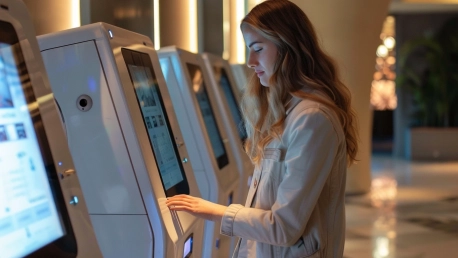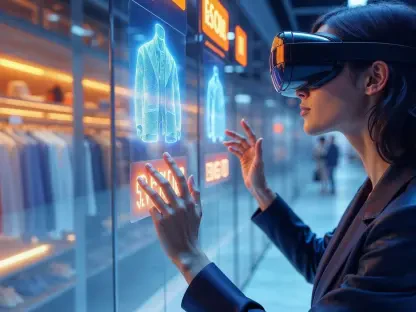The retail industry is undergoing a seismic shift driven by rapid technological advancements, with the integration of IoT, AI, AR, and other cutting-edge innovations profoundly reshaping how retailers operate and engage with customers. Central to this transformative journey is the burgeoning adoption of automated self-service kiosks, which exemplify the broader digital revolution taking place in retail. These kiosks are not only enhancing operational efficiency but also significantly improving customer convenience, heralding a new era of retail experiences. As the sector embraces these technological marvels, the landscape of retail is set to undergo unprecedented changes, paving the way for a future where human interaction is seamlessly augmented by intelligent machines.
The Rise of Automated Self-Service Kiosks
Automated self-service kiosks are emerging as a cornerstone of retail technology innovation, offering a spectrum of self-service options, including price checks, order placements, self-checkout, returns, and membership registrations. Retailers have begun to recognize the substantial benefits these kiosks bring, both in terms of operational efficiency and customer satisfaction. The introduction of these kiosks marks a pivotal shift towards reducing the need for direct human intervention, streamlining the shopping experience, and significantly reducing wait times. This results in an enhanced level of customer satisfaction, as shoppers enjoy quicker and more efficient service.The versatility and multifaceted functionality of automated self-service kiosks have rendered them indispensable in modern retail environments. Their ability to handle a wide array of tasks allows retailers to allocate their staff more effectively, directing human resources to areas that demand personalized attention and service. This transition not only optimizes workforce deployment but also elevates the overall shopping experience. The substantial surge in patent activity related to self-service kiosks further underscores their potential. With industry leaders like Outerwall, Cleveron AS, and PepsiCo at the forefront of this innovation space, it is evident that substantial investments are being funneled into capitalizing on the myriad advantages that these kiosks offer.
Understanding the Innovation Lifecycle S-Curve
Technological advancements in retail do not follow a straightforward linear progression; instead, they advance along an S-shaped curve. This model delineates the stages from early emergence to accelerating adoption and eventual maturity, providing a framework for understanding the evolution of innovations. Recognizing the current stage of a technology on this curve is crucial for predicting its future impact and adoption levels. Automated self-service kiosks are currently positioned in the early stages of this curve, exhibiting promising potential but far from reaching peak adoption.During this nascent phase, automated self-service kiosks undergo exploratory implementations where retailers and consumers provide initial feedback. Insights gleaned during this period are instrumental in refining and optimizing the technology for broader, more widespread application. Other retail innovations, such as smart checkout systems and modular autonomous delivery bots, have progressed further along the curve, experiencing accelerating adoption. These technologies have surpassed initial trials and are now being implemented on a larger scale, signaling their growing acceptance and reliability within the industry.
The Role of Data Analytics in Retail Innovation
In the contemporary retail landscape, data analytics plays a pivotal role, offering retailers deep insights into consumer behavior and operational efficiencies. By harnessing the power of data analytics, retailers can make informed decisions that aim to enhance customer experience and streamline operations. Automated self-service kiosks are integral to this data-driven ecosystem, generating and analyzing real-time data on customer interactions and preferences. This wealth of data empowers retailers to optimize product placements, manage inventory more effectively, and tailor marketing strategies to meet individual customer needs.IoT-enabled self-service kiosks contribute significantly to this data-empowered environment by capturing comprehensive data ranging from user interface interactions to detailed transaction histories. This data is not only invaluable for improving the functionality of self-service kiosks but also enhancing the overall business strategy of retailers. Companies like GlobalData utilize patent analytics to monitor global trends and innovations in IoT applications within the retail sector. This data offers a panoramic view of the technological landscape, assisting businesses in identifying lucrative opportunities for investment and development.
COVID-19: A Catalyst for Accelerating Adoption
The COVID-19 pandemic acted as a powerful catalyst in accelerating the adoption of automated self-service solutions across the retail sector. Faced with the challenges of ensuring safer and more efficient transactional methods, businesses and consumers turned to contactless technologies, propelling the demand for automated self-service kiosks. These kiosks emerged as a crucial tool in facilitating safe and seamless shopping experiences during the pandemic, minimizing physical contact and streamlining transactions.The shift towards self-service solutions, spurred by the pandemic, has maintained its momentum even as restrictions have eased. Retailers have come to appreciate the enduring benefits of these technologies, which include minimizing physical interactions, reducing labor costs, and enhancing operational efficiency. As a result, the deployment of automated self-service kiosks has become more prevalent, solidifying their role within the retail environment. Furthermore, the pandemic also prompted a significant shift in consumer behavior, leading to increased familiarity and comfort with automated solutions. This heightened consumer acceptance continues to drive ongoing adoption, ensuring that self-service kiosks remain a staple in modern retail.
The Competitive Edge through Patenting
Securing a competitive edge in the retail industry increasingly hinges on the strategic deployment of innovative technologies. Companies are now focusing on expanding their patent portfolios, targeting diverse applications and broadening their geographic reach. This strategic approach ensures that they remain competitive and can effectively capitalize on various market opportunities. A prime example of this trend is PepsiCo’s Quik Pick kiosk. By incorporating IoT and AI technologies, including computer vision, PepsiCo has developed a more efficient and profitable vending solution compared to traditional models.Innovations such as these are safeguarded through robust patent portfolios, providing companies with a strategic advantage by protecting their intellectual property. Citigroup stands out for its application diversity, showcasing a wide range of patent applications across various retail functions. Similarly, Fiserv leads in geographic reach, indicating the widespread application of its patented technologies across multiple regions. This dual focus on application diversity and geographic expansion is essential for maintaining a strong competitive position in the dynamic and evolving retail landscape.
The Future of Retail Innovation
The retail industry is experiencing a seismic transformation driven by rapid technological innovations. IoT, AI, AR, and other advanced technologies are revolutionizing how retailers operate and interact with customers. At the forefront of this change is the increasing use of automated self-service kiosks, which serve as a prime example of the digital revolution in retail. These kiosks are boosting operational efficiency while greatly enhancing customer convenience, signaling a new era for the retail experience. By embracing these technological advancements, the retail landscape is poised for unprecedented changes. This shift will enable intelligent machines to seamlessly augment human interactions, offering a more streamlined and personalized shopping experience. As retailers continue to integrate these cutting-edge technologies, they will innovate in ways that were once unimaginable, ensuring a future where technology complements human expertise. Thus, the retail sector is on the brink of a transformative journey where digital and human elements work in harmony to create enriched customer experiences.









